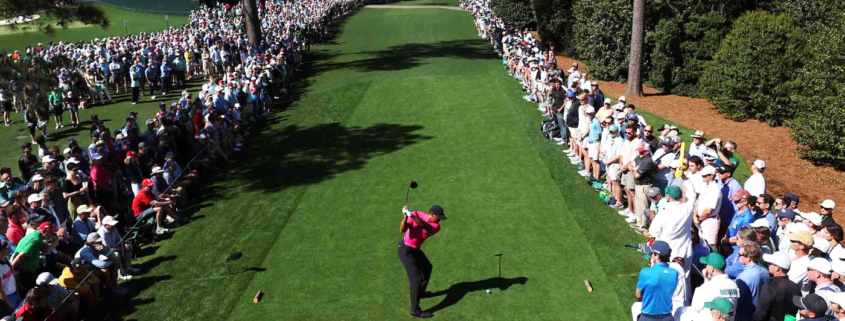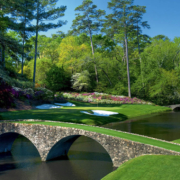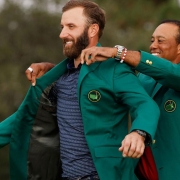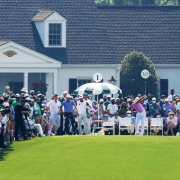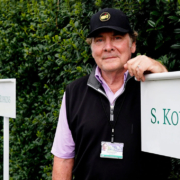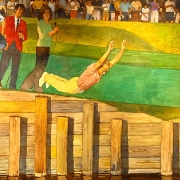A Big Week at The Masters
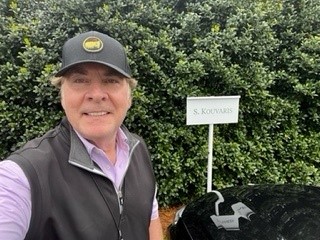 “You’ve had a big week,” my long-time friend “The Ghost” texted me on Sunday of this year’s Masters Tournament.
“You’ve had a big week,” my long-time friend “The Ghost” texted me on Sunday of this year’s Masters Tournament.
And he was right.
After a two-year delay, Augusta National and the Masters celebrated my more than four decades as a reporter at the tournament, presenting me with the Masters Major Achievement Award. I’m very grateful to the Augusta membership and the Tournament’s Media Committee and staff for taking the time to recognize my work. It’s the best sporting event in the world and they value tradition, loyalty, and good work like no other.
As part of the Award, they invited my entire family to Augusta for a banquet on Wednesday night and a chance to experience The Masters in person all week. I can’t tell you how much that meant to me and how wonderful it was to have them there for the week. It’s always great to see people’s reaction to their first time at Augusta National. But after years of me working nights and traveling, and them putting up with that, to see them experience what I’ve had the privilege of being a part of in my career was so gratifying, it’s hard to describe. For that, Augusta National and The Masters will have my unending gratitude.
As you might imagine, there are a lot of highlights for me at Augusta, topped by this week. But here are a few others, starting at the beginning
It’s been forty-three years since I covered my first Masters. In January of 1979, an invitation from Augusta National to apply for a credential to cover that year’s Masters Tournament came to my desk at Channel 2 in Charleston, South Carolina. I was shocked, and thrilled. As a new reporter in my first job as the Sports Director there, I was 23 years old and was just learning about the big events and what it was like to be involved.
When I arrived at Augusta National in April, I’m sure I looked lost because Tom Place, the regular PGA Tour media director, saw me outside the Quonset hut that served as the press room clearly bewildered.
“Sam, you look lost,” he said kindly.
“Because I am Tom!” I told him.
Place showed me around the press facility, and as a 23-year-old I was amazed to see legendary writers and broadcasters I had only read about. Herbert Warren Wind, Furman Bisher, Dan Jenkins, Edwin Pope, and others were the titans of the industry I was lucky enough be a part of at that moment. Here they were, right in front of me, and doing their jobs.
Whenever I walked through the front door of the Press Building, I always instinctively walked to the right. Because in my first experience there, the left side of the press room had a table with a bunch of liquor bottles on it, clearly a post-round ritual for those seasoned at their profession. I knew I hadn’t earned that and stuck to the right side for the rest of my time there.
That first year I was working as a one-man sports department, so I asked Martha Wallace, the credential coordinator for the Masters if I could bring my dad as my photographer. She said yes, and I was excited to teach my father how to run the little industrial camera we were using in back then.
We stayed in a house listed by the Masters Housing Bureau. In 1979, there were only a couple of hotels in Augusta, so residents rented rooms, or their entire home for the week of the tournament.
I think of that often, as my father was 46 years old, twenty years younger than I am now. And as the son of immigrants from the streets of Baltimore, he was awestruck by the beauty of Augusta National. So awestruck in fact, I occasionally had to reel him in to do his job!
When Fuzzy Zoeller won that year in a playoff at eleven, the member taking him to the press room stopped and delivered Zoeller right to me standing behind the first tee. It was dark, and I remember asking Fuzzy a question and seeing a dozen or so microphones come out of the darkness and pointing at me to continue the interview. “Whoa, this is a big deal,” I remember thinking.
Before I asked the first question, I could hear my Dad saying, “I can’t see him, I can’t see him” as I turned on the light. I glanced back, and noticed the viewfinder was pointed at Zoeller but the camera had hinged toward the ground. I grabbed it with one hand and maneuvered it at Fuzzy, only to hear my dad say, “Oh, there he is.”
The following year I was able to secure a ticket to the tournament for my new wife, Linda. We were walking up the left side of the first fairway, chatting, when a security guard stepped in front of us with his arm held out from his side. He didn’t say a word but when I glanced to my right, Seve Ballesteros was crouched down in between some trees, not three feet from us looking at a small, window-like opening between some branches for his second shot. We literally had almost stepped on him! In what became typical Seve style, he executed a six-iron from the woods onto the green and made birdie on his way to his first green jacket.
In 1981, Tom Watson won his second title at Augusta National and a picture of me was included in the Masters Yearbook. In what looks like a historical time capsule image now, I’m standing next to the clubhouse, waiting my turn in the dark to interview Watson. Little did I know that the following week I’d be in Jacksonville interviewing for a new job.
I was working in Jacksonville in April of 1982, and I missed the Masters Tournament that week. My daughter Austin was born that week. Linda’s labor was long, so our OBGYN, Dr, Richard “Dickie” Meyers and I brought a small black and white television into the room to keep up with the tournament. I’m not sure what Linda thought about that. She claims to not remember!
Operating a small sports department at the television station in Jacksonville, I wrote, anchored, produced, and edited all the on-air shows, not unusual at the time. I also acted as my own cameraman/photographer. Occasionally, The Masters would offer me a photographer’s credential, and in 1985, Tom Wills, our anchorman, came along to Augusta to fill that role. We were down on Amen Corner when Curtis Strange made par on 12 to grab a three-stroke lead with six holes to play. We decided to pack up and leave, figuring the tournament was over. Little did we know that Strange would find the water on both 13 and 15 to let everybody back in the tournament. Bernhard Langer birdied four of the last seven holes to win the first of his two Masters titles. Tom and I still laugh about that to this day.
Anybody who’s been around The Masters for a while references Jack Nicklaus’ win in 1986 as a highlight. I was standing right behind the 18th green when Nicklaus completed his round. Everybody talks about the birdie on 17 but Jack’s two-putt on 18 was equally impressive. From the front of the green to a back-right pin placement, Nicklaus calmly finished out a back nine 30 with what, on paper, looks like a routine par at the finishing hole. It was anything but. Jack said later that he knew the putt well, having been asked by Augusta National, in his role as a golf course builder, to reshape the 18th green a bit.
He made the slope from front to back shallower and had hit that putt “a thousand times” while working on the hole. Greg Norman famously missed the green to the right and failed to get up and down for par to finish a shot back. Tom Kite hit a magnificent shot to ten feet and had a chance to tie for the lead, only to lip out his put and tie for second. I walked with Nicklaus over to Butler cabin after he came out of the scoring tent behind the 18th green (at the time). There were patrons everywhere and it would be an understatement to say they were “excited.”
Covering about ten professional golf tournaments each year, I got to know many of the players of that era. I was friendly with Greg Norman in his heyday and went through the gamut of emotions with him after each close call at Augusta. Fred Couples and I knew each other well, and he was friends with my brother Gust, so it was exciting to see him put on the Green Jacket in 1992.
You might remember Couples’ shot on twelve stopped on the bank in front of the green and helped propel him to victory. Standing on that tee playing the hole a year later, I mentioned that shot to my caddie.
“Haven’t seen a ball stop there ever before or ever since,” he said shaking his head.
With Tiger’s victory in 1997, the whole golf world changed. He went on to be the most dominating player of the next twenty-five years and brought a whole new group of fans to the game. That was important in my position as the Sports Director of a television station in Jacksonville Florida.
A little more than thirty percent of Jacksonville’s population is Black, and golf was not a very big, or oftentimes not generally accepted sport in the Black community. Many leaders in the Black community let me know that in my first twenty years in Charleston and North Florida, telling me I covered too much golf for their liking. I would explain that I thought it was important to cover golf because North Florida was home to the PGA Tour’s headquarters and we had a very significant golf championship in our back yard, then known as the “TPC.”
Their disappointment in my choice of coverage never abated until Tiger’s Masters win. His victory, and domination of the golf world changed all of that, even in my small world of local television coverage.
Over the next decade, Tiger and Phil Mickelson won six of the next ten Masters titles but David Duval of Jacksonville also emerged as a top-flight competitor and ascended to the number one player in the world. His near misses at Augusta are part of the tournament’s lore. He invited me to caddie for him at the Par 3 Tournament one year in that stretch and it was a fun as it looks. Dressed in the white jump suit with “Duval” affixed to my back, David’s only instructions were “keep up and don’t lean on the putter.” When his bag fell over as I was delivering a sand wedge two him on the second hole, I was mortified but David lightly gave me the needle saying, “You had one job,” with a laugh.
As we walked the short fairways and tight tee boxes, there wasn’t much room because of the number of patrons lining every step of the way. When we got to the eighth hole, David was mildly in contention and asked what club I thought he should hit. “It’s wedge,” I said, drawing on what I had seen him do over the first seven holes. “I think it’s nine iron,” he deadpanned. “There’s a bit of wind behind us and it’s severely downhill. It’s a solid wedge,” I repeated.
Duval calmly pulled the nine iron from his bag, and without a glance, hit a beautiful, high, arching shot right at the hole. And it landed five feet past the flagstick, checked, and rolled off the back, into the water. He gave me a “don’t say a word” look, and we walked down the hill. In retrospect, I’m not sure David didn’t do that on purpose. A birdie there might have given him the title, and no player has ever won the par 3 and the Masters in the same year. So maybe he wasn’t going to tempt fate.
After a nice shot to eight feet across the lake at nine, we were standing on the green when David handed me his putter and said, “Now it’s your turn.” I gave him one of my “Really?” answers and promptly missed the putt on the right. “I told you it went left,” David said with a laugh as we walked on the back of the green to the kind of applause that only happens at Augusta.
Wins by Bubba Watson, Adam Scott, Jordan Spieth, and Sergio Garcia over the next ten years were fun and make me smile when I recall wins for players who passionately competed for the title of “Masters Champion” and finally achieve that goal. Despite trying to maintain journalistic integrity, I always find myself trying to will certain players I like to victory. That was especially true with Scott and Spieth.
The win by Tiger in 2019 rivals Nicklaus’ victory in ’86. Watching Brooks Koepka and Francesco Molinari hit it in Rae’s Creek playing the twelfth, seemingly victims of the “golf gods,” the “Tiger effect,” and their lack of experience playing Amen Corner holding the lead. Woods’ calmly hitting the ball to the center of the green and waiting as they played their shots from the drop area showed Tiger’s experience and steely nerve and was one of the best photographs of the year.
My 40th Masters was the only one played in November of 2020. Because of the pandemic, the tournament had been postponed until the fall of that year. To paraphrase my friend Jim Nantz, that was an “experience like no other.” I wrote about it here: https://www.samsportsline.com/a-walk-at-the-masters/ That’ll be a “memory like no other” for sure. Being alone on Amen Corner might be the most serene spot I’ve ever experienced.
And this week will not only be one of my most special memories of Augusta, but also one of the great weeks of my life. To have my family around, and to see and hear from so many friends who offered heartfelt congratulations was humbling and yes, fulfilling as well.
GolfWeek wrote about the award ( https://www.samsportsline.com/sam-kouvaris-receives-masters-major-achievement-award/ ). Thanks to Adam Shupak for his kindness and accuracy in reporting. The “cigar” story is true and makes me laugh every time.
If you every are at Augusta and see me on my “walk,” please stop and say hi. I’m sure we’ll both enjoy it.

